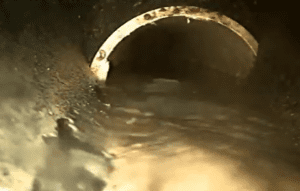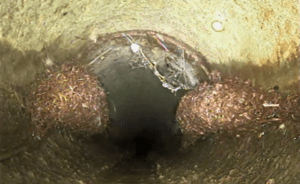Whether your home is on septic or public sewer, the main sewer line is an integral part of your homes’ plumbing system. The main objective of this sewer line is to carry wastewater from your home safely. Although sewers have been discovered in ancient ruins dating back to 2500 BC, no system or material has proven to stand the test of time. Early sewer development revolved around open drains / ditches designed to carry stormwater, but the rains also flushed away piles of excrement and debris thrown into the streets. During storms, these ditches were sources of a horribly revolting stench. During the Roman era, sewer designers developed cesspools, forerunners of modern day septic tanks. These open drains and cesspools led to much of the illness associated with the diseases that spread across Europe in the 1800’s. Between a quarter and a third of the population died from cholera, typhoid fever and plague.
Today’s sewers, although much more advanced, can have significant problems that are costly to fix. With sewer lines being buried in the shallow range of 18 inches, to 9 or more feet in the case of basement installations, the cost to repair or replace a sewer line ranges wildy between a couple thousand to tens of thousands of dollars. Many factors can escalate the cost of a sewer repair drastically. Besides depth, the biggest other factor will be accessibility. Large trees, additions, streets, sidewalks and even easements onto other neighboring properties may complicate things.
In some jurisdictions, the homeowner is only responsible from their property line. In many jurisdictions, however, the homeowner is responsible for the entire sewer line, up to the connection with the utilities main sewer. Costs for digging up and repairing the street and sidewalk would then fall on the homeowner, in these areas.
The most typical and concerning condition for home buyers is root intrusion. Root intrusion begins as a leak in the pipe. As a leak continues, plants, such as trees and shrubs, find the moisture and grow roots towards the source. Once feeder roots enter the pipe, they continue to grow, slowly filling the available space. In some cases, root intrusion can go unnoticed for years before causing a backup.
Another condition, even found in new sewer systems, are bellies or dips in the line. This condition is typically the result of settlement in the surrounding soil. Almost all sewers will have notable changes in slope from this condition. The biggest concern associated with bellies is the disruption of flow within the line, which may trap heavy objects / particles, creating a blockage over time. We also tend to find a build up of soap scum, fats / greases in these areas.
Offsets are another typical condition that may be problematic. There are two types of offsets, referred to as “in favor” and “not in favor”. An in favor offset is a small offset where sewage “falls” into the next pipe, in the direction of flow. An offset that is “not in favor”, means that the sewage must rise in the pipe in order to flow into the next section of pipe that sits higher than the previous section. If too drastic in either configuration, solids within the sewer may not be able to pass through the offset and create a blockage.
Besides these common defects, in older homes, pipe material and condition come into play. Older homes with clay, concrete or cast iron pipes are likely past their life expectancy and should be expected to need repairs in the near future. Cast iron pipes can last 75-100 years, however, there are many factors that will contribute to their performance. Cast iron pipes, being a manufactured product, are subject to quality control and purity issues. Because most of these lines are buried underground, they are corroding from both the inside and outside of the pipe. As cast iron ages, large flakes of rust / scale can unexpectedly break loose and cause blockage.
Because of the extensive cost associated with sewer repair and replacement, it has sparked innovative solutions to reduce the cost and invasiveness of repairs. For most failed sewer lines, they can be cleaned and lined with a thin liner that takes the shape of the existing pipe. Another trenchless repair option, is to pull a new line comprised of HDPE plastic, through the existing line. These repairs are great options for properly graded sewer lines, unfortunately, these will not correct dips or bellies in an existing sewer.
Since modern sewer lines are buried and cannot be visually inspected without specialized equipment, it is recommended that anyone purchasing a property have the main sewer line scoped for possible defects, regardless of age.


